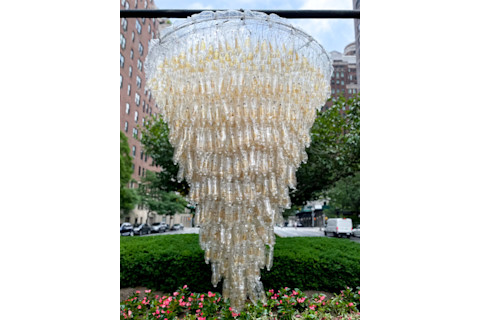This article was originally published on Nexus Media News.
Duke Riley started out making maritime crafts, like sailor’s valentines and scrimshaws, entirely out of shells, bones and other natural materials that washed ashore on the beaches of Cape Cod, Massachusetts and greater New York. Then, on a walk in 2017, he picked up what he thought was a piece of bone. Upon closer inspection, he realized it was a plastic brush used for scrubbing boats.
The moment marked a turning point in his practice.
“I want to make pieces that reflect the actual condition of the shoreline,” said Riley, an artist who splits his time between Brooklyn and a houseboat docked off the coast of Rhode Island. That meant mixing up his medium.
Last year, Riley showed more than 200 pieces of art at the Brooklyn Museum made from thousands of pieces of plastic — detergent bottles, toothbrushes and tampon applicators, among other things — that he and fulltime garbage-picker Michele Klimczak collected from East Coast beaches.
Humans produce about 8 billion tons of plastic each year. Plastic production is responsible for about 4.5% of all greenhouse gas emissions, nearly twice as much as what the aviation industry produces. Only about 9% of all the plastic ever produced has ever been recycled. It seeps into rivers and streams. It lives in the bellies of fish and seabirds. Microplastics pump through our veins and accumulate in our lungs.
The scale of the plastics crisis is almost incomprehensible. But increasingly, artists and museums are bringing attention to the problem and challenging audiences to rethink their consumption habits.
In May, the Venice Biennale of Architecture hosted “Everlasting Plastics,” an exhibition examining humanity’s “fraught kinship” with the material through the work of five artists. Works included baskets made from recycled plastic bottles and sculptures that appear to be dripping in hot, molten plastic.

One of Willie Cole’s water-bottle chandeliers on Park Avenue, on Manhattan’s Upper East Side. (Credit: Willie Cole)
Willie Cole
“From toys to camping coolers, plastic is deeply embedded in the culture of the United States, where polymers were perfected and exported,” said co-curator Lauren Leving in a statement. “Our toxic relationship with the material is now a global phenomenon.”
In June, artist Beverly Barkat unveiled a 180-panel globe made from plastic waste in Lower Manhattan. And in July, sculptor Willie Cole installed four chandeliers made from 9,000 discarded water bottles on Park Avenue, on Manhattan’s Upper East Side.“In many respects, the issue is abstract and largely intangible,” says Riley, pointing out that the plastics problem goes beyond what we can see. “While there are no easy answers, I think art can help people begin to wrap their heads around it and find a way to talk about these problems.”
Brooklyn Museum’s Liz. St George, who curated Riley’s exhibition, said she observed museum-goers reflecting on their personal consumption habits as they examined Riley’s artworks. “They’ll see a plastic item like a dental pick and say, ‘I use this every day,’” she said.
Artists aren’t just exploring plastics in their work, St. George said. They’re also addressing the crisis in more tangible ways. Riley, for one, organizes clean-ups along the shores of Gunnison Beach in New Jersey.
Back in 2008, artist Aurora Robson, who creates ethereal, starburst-like sculptures out of plastic, started Project Vortex, a collective of artists and designers who create and support projects to repurpose single-use plastics. The group has developed an academic curriculum on working with plastic debris, and Robson frequently teaches workshops to schoolchildren in which she encourages them to make art out of things they’d normally throw away.
Robson sees the climate and plastics crises as problems of imagination requiring creative problem-solving above all. She said: “If I’m doing my job, I’m instilling hope and making other people think, ‘If she can do that with plastic, what can I do?’”
Willie Cole, an artist in residence at Rutgers University, said his chandeliers show just how entrenched plastics are in everyday life — and how difficult it will be to quit the stuff. The plastic bottles he works with recall the 70,000 cases of plastic water bottles that were distributed in his hometown of Newark, New Jersey after the Environmental Protection Agency (EPA) declared the city’s lead-contaminated water unsafe to drink.
Cole describes himself as a “perceptual engineer,” whose work can offer a new way of seeing the world. He said he hopes his sculptures inspire viewers to rethink their own consumption habits. “I can’t change the world,” he said. “But I know that every time I make a chandelier, people donate their plastic water bottles to me.”














